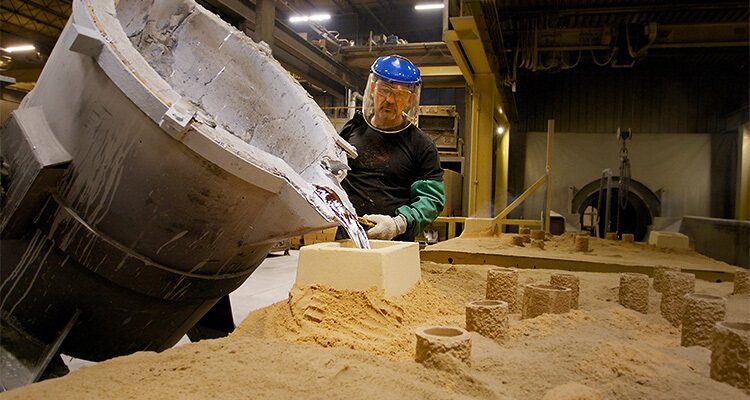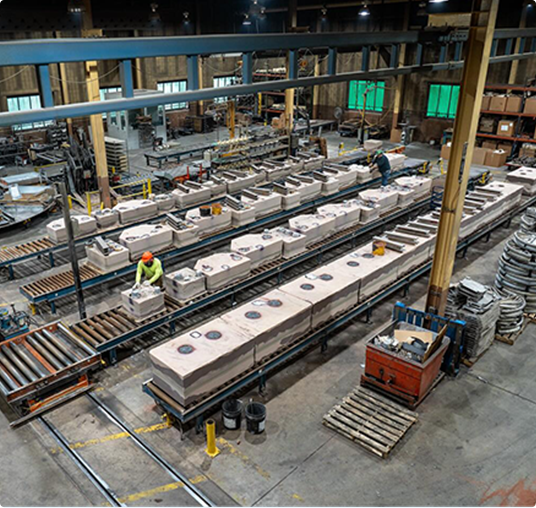How Aluminum Castings Enhance Sustainable and Eco-Friendly Production Practices
Wiki Article
Checking Out the Innovative Methods Utilized in Modern Aluminum Foundries
Modern aluminum foundries are undergoing a substantial improvement with the adoption of ingenious methods. Advanced casting methods, smart automation, and sustainable methods are improving production procedures. These developments not only boost efficiency however likewise address environmental issues. As the industry progresses, the integration of electronic technologies plays a necessary duty. Comprehending these modifications is important for understanding the future of aluminum production and its implications for global markets. What exists in advance in this dynamic sector?Advanced Casting Techniques

In addition, advancements in thermal control and mold and mildew design have added to even more regular casting results. These innovations enable better control of cooling rates, minimizing flaws and improving mechanical homes. Consequently, manufacturers can develop light-weight yet long lasting parts, fulfilling the increasing demands of various sectors, consisting of automotive and aerospace, for high-performance aluminum parts.
Smart Automation and Robotics
The integration of clever automation and robotics in aluminum foundries marks a significant innovation in producing efficiency. These modern technologies allow accuracy and consistency in manufacturing processes, drastically minimizing human error and boosting safety. Automated robot systems manage recurring tasks, such as molding, putting, and air conditioning, enabling human drivers to concentrate on even more complex duties that require essential thinking and oversight.In addition, ai-driven analytics and clever sensors give real-time data surveillance, helping with anticipating maintenance and lessening downtime. This leads to maximized resource appropriation and enhanced power consumption, adding to overall sustainability in manufacturing.
The adaptability of robot systems allows for fast adjustments to altering production needs, enhancing versatility in manufacturing. As foundries significantly embrace these advanced modern technologies, they not only boost functional performance yet additionally position themselves as leaders in technology within the steel casting industry.
Additive Manufacturing in Foundries
Transforming conventional production techniques, additive manufacturing is reinventing aluminum foundries by making it possible for the production of intricate geometries that were formerly unattainable. This strategy enables the layer-by-layer building and construction of parts, greatly reducing product waste and reducing manufacturing times. As an outcome, foundries can create complex styles that improve performance and functionality, dealing with the expanding needs of different markets.Additionally, additive manufacturing facilitates quick prototyping, permitting designers to evaluate and iterate designs promptly. This dexterity not just speeds up the development cycle yet additionally assists in identifying potential concerns prior to full-blown production starts. The assimilation of sophisticated materials and procedures in additive manufacturing even more enhances the mechanical properties of aluminum components, advertising advancement in product layout. Subsequently, aluminum foundries that adopt these strategies position themselves at the center of industry innovations, making sure competitiveness in an ever-evolving market landscape.
Sustainable Practices and Recycling
Lasting methods in aluminum foundries are increasingly concentrated on enhancing reusing processes and taking on green casting methods. These technologies aim to lower waste and energy intake while making the most of making use of recycled materials. As the market evolves, the combination of sustainability into manufacturing approaches becomes essential for satisfying environmental standards and consumer needs.Reusing Process Improvements
As industries significantly acknowledge the ecological impact of waste, aluminum foundries are taking on innovative recycling procedure improvements to improve sustainability. These innovations focus on reducing energy intake and making best use of product recovery. For example, many foundries are carrying out closed-loop systems that recycle scrap aluminum produced throughout production, reducing waste and minimizing the requirement for virgin products. Advanced arranging innovations, such as computerized optical sorting, boost the splitting up of different aluminum grades, enhancing the effectiveness of the recycling process. Additionally, some foundries are utilizing hydrometallurgical approaches to recoup aluminum from intricate waste streams. By incorporating these enhancements, aluminum foundries not only add to a circular economy yet additionally lower their carbon impact, lining up with worldwide sustainability goals.Eco-Friendly Casting Techniques
While conventional casting methods typically include considerable energy intake and product waste, aluminum foundries are significantly embracing environment-friendly casting methods that prioritize sustainability. Techniques such as low-pressure die casting, which minimizes air exhausts, and the usage of water-based mold and mildew releases contribute to reduced ecological effect. Additionally, advancements in 3D printing modern technology enable the development of complicated mold and mildews with much less material waste. Several foundries are likewise executing closed-loop systems that reuse water and aluminum scrap, more reducing resource intake. By welcoming renewable resource resources, such as solar and wind power, these facilities enhance their sustainability initiatives. In general, the fostering of environment-friendly practices in aluminum casting not just benefits the atmosphere but likewise promotes economic performance and advancement within the sector.Improved Quality Assurance Steps
Boosted quality assurance procedures in aluminum foundries are increasingly dependent on advanced examination innovations and real-time monitoring systems. These developments make it possible for producers to identify problems early and ensure consistent product high quality. By incorporating these tools, foundries can considerably enhance their functional efficiency and minimize waste.Advanced Examination Technologies
Advanced evaluation modern technologies play a necessary role in guaranteeing the high quality and integrity of aluminum spreadings. These sophisticated techniques consist of non-destructive screening (NDT) techniques such as ultrasonic testing, radiographic screening, and eddy existing examinations. Each method enables for thorough examination of castings without endangering their structural stability. Advanced imaging strategies, such as computed tomography, supply a comprehensive sight of internal features, enabling the detection of flaws like gaps and inclusions. In addition, automated optical evaluation systems boost precision by using high-resolution cams and equipment learning algorithms to analyze surface top quality. By carrying out these sophisticated assessment innovations, aluminum foundries can efficiently minimize defects, click to investigate making sure that spreadings fulfill strict industry criteria and consumer demands.Real-Time Monitoring Equipments
As makers venture for excellence in aluminum casting, real-time surveillance systems emerge as a critical improvement in high quality control steps. These systems utilize sophisticated sensors and data analytics to continuously track essential specifications during the casting procedure, such as temperature, alloy, and stress structure. By providing instant feedback, they make it possible for operators to recognize discrepancies from excellent conditions and make punctual modifications. This aggressive technique not just lessens defects yet also boosts overall effectiveness and reduces waste - Aluminum Castings. Furthermore, integration of real-time data right into production monitoring systems helps with far better decision-making and enhances traceability. Real-time surveillance systems play a vital role in keeping high criteria of quality in modern aluminum foundries, making sure that items fulfill rigorous industry specs.Digital Double Modern Technology for Optimization

The combination of electronic twin you can try this out innovation allows foundries to examine various circumstances without interfering with real manufacturing. This capacity promotes a positive approach to maintenance and source monitoring, inevitably lowering waste and decreasing operational prices. In addition, the innovation aids in procedure optimization by permitting engineers to visualize the results of adjustments in real-time, making sure better outcomes. Because of this, aluminum foundries taking on electronic twin innovation are positioned to achieve better efficiency and competition in a progressively requiring market.

Market 4.0 and IoT Combination
The fostering of electronic twin modern technology in aluminum foundries belongs to a broader movement in the direction of Market 4.0, characterized by the assimilation of the Web of Points (IoT) right into manufacturing processes. This assimilation makes it possible for real-time monitoring and data collection from numerous equipment and equipment, causing boosted operational efficiency. Sensors installed in equipments gather vital information, which is assessed to optimize production workflows and anticipate upkeep demands.Furthermore, IoT gadgets assist in interaction in between various manufacturing phases, permitting seamless coordination and reducing downtime. By leveraging cloud computer, foundries can keep and assess vast amounts of information, enabling more informed decision-making. This innovation additionally sustains remote monitoring, where drivers can oversee processes from anywhere, enhancing responsiveness to manufacturing obstacles. Overall, the fusion of Industry 4.0 and IoT within aluminum foundries is transforming traditional techniques, making them extra dexterous and responsive to market needs.
Regularly Asked Inquiries
What Are the Key Advantages of Aluminum Over Various Other Steels?
Aluminum supplies countless benefits over various other steels, including its lightweight nature, exceptional corrosion resistance, high useful link thermal and electrical conductivity, pliability, and recyclability, making it a recommended selection for various applications across multiple markets. - Metal CastingsHow Do Modern Foundries Handle Hazardous Products?
Modern foundries take care of hazardous products with rigorous security protocols, progressed filtering systems, and recycling techniques. Routine training warranties workers understand ideal practices, while monitoring systems identify and minimize prospective dangers to keep a risk-free working setting.What Is the Normal Lifespan of Aluminum Castings?
The normal lifespan of aluminum spreadings ranges from 20 to half a century, depending upon variables such as ecological conditions, use, and maintenance. Appropriate care can expand their durability and performance considerably in time.Are There Any Type Of Wellness Dangers Related To Aluminum Foundry Work?
Yes, aluminum shop work presents health dangers, including respiratory system issues from breathing in fumes and dust, skin irritability from contact with molten steel, and potential direct exposure to dangerous chemicals. Proper security actions are vital to minimize these threats.Exactly How Do Factories Make Certain Worker Security in High-Temperature Environments?
Factories carry out strenuous safety and security protocols, including safety equipment, temperature monitoring systems, and regular training. These measures assure that employees are furnished to manage high-temperature atmospheres, lessening dangers and advertising a much safer office.
Countless advanced casting strategies have actually arised in aluminum foundries, transforming typical procedures. Lasting practices in aluminum foundries are increasingly focused on boosting reusing procedures and adopting environment-friendly casting strategies. Several foundries are executing closed-loop systems that reuse scrap aluminum created during manufacturing, lessening waste and minimizing the need for virgin materials. While conventional casting techniques frequently include considerable power consumption and material waste, aluminum foundries are significantly embracing green casting strategies that prioritize sustainability. While lots of industries are progressively adopting digital modern technologies, aluminum foundries are leveraging digital twin modern technology to improve functional efficiency and maximize production processes.
Report this wiki page